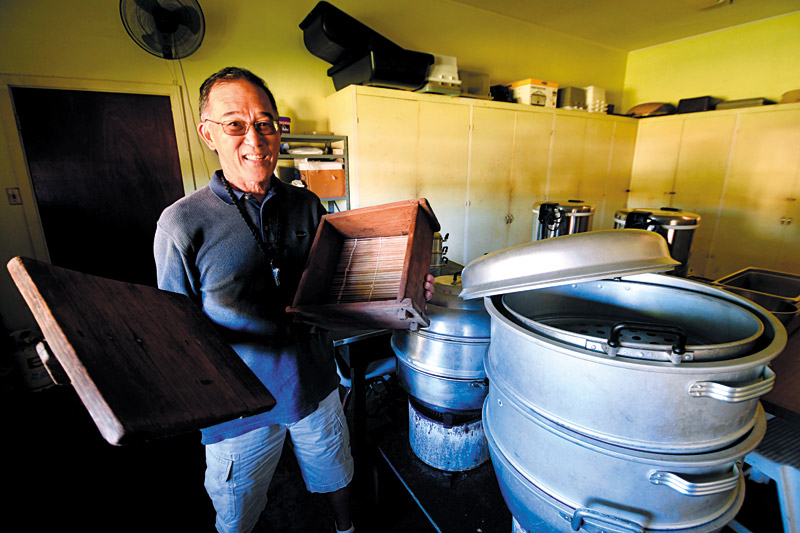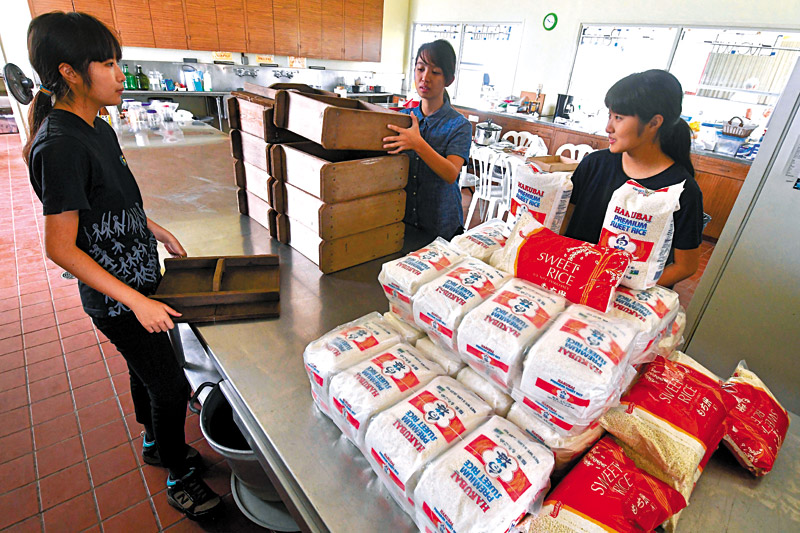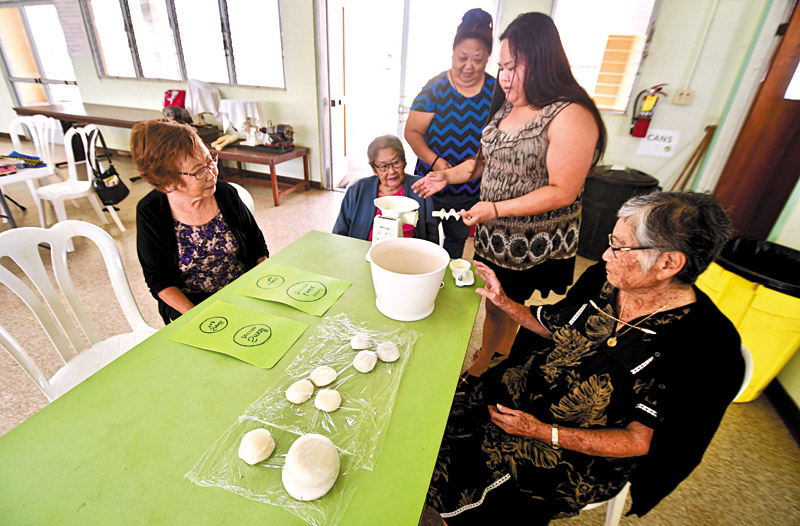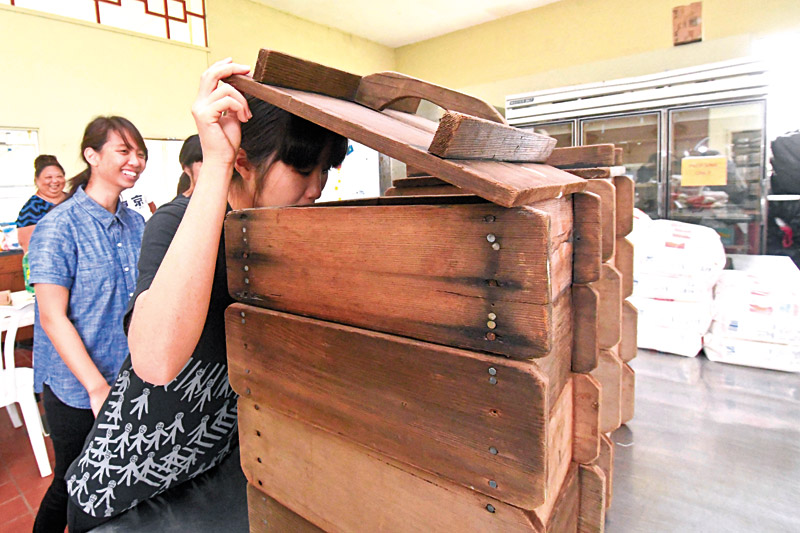Mochi Goes Modern

Gerald Hirata, president of Soto Zen Temple in Hanapēpē, looks over the contemporary steam cookers, comparing them to the original wooden trays and mats previously used to make mochi rice.
Machines might have replaced wooden hammers in the mochitsuki process, but one thing that won’t change is the desire to pass down the symbolism and importance of the ritual to future generations.
It’s the Saturday after Christmas in the early morning hours of 4 a.m. But, while many Kauaians are fast asleep following holiday merriment, Gerald Hirata, president of Soto Zen Temple in Hanapēpē, is already hard at work preparing for the church’s annual mochitsuki (Japanese mochi-making) ceremony.
More than 300 pounds of rice will be cooked over three different burners in large two-tiered steamers, ensuring it’s ready for the 30 volunteers that will dedicate their morning to producing mochi in assembly-line format.
During the process, the hot rice is scooped and fed into a motorized grinder, churning until it has the perfect sticky consistency.
The globs of mochi are then placed into hand-powered cutting machines, similar to sausage grinders. Flour is used to prevent sticking. Mochi pieces are sectioned off and sent down the assembly line for volunteers to shape into its familiar circular form.

Iris Murakami, Cherish Kuloloia and April Murakami do a mochi-making dry run at Kapa‘a Hongwanji Mission’s social hall.
Finally, the mochi is laid out onto cooling tables and the flour dusted off. By noon most of the work is done, and the packaged mochi is ready for pickup.
According to Hirata, the church tradition of mochitsuki dates all the way back to Kaua‘i’s plantation days, probably to the beginning of the Soto Zen Temple, established in 1903. The first known mochitsuki dates back even further, sometime between 300 BC and 300 AD in Japan.
“We see it as a year-end ritual that is cultural, historical and social,” says Hirata. “In Asian cultures, the New Year is the most important time of the year. It puts an end to what has happened in the past year and offers a fresh start for the new one.
“There’s a sense of hope and optimism, in addition to the seasonal holiday spirit of good tidings, peace, goodwill to all. This is a universal theme, so all cultures partake in some kind of year-end activity. These mochi rituals are culturally Japanese, but in Hawai‘i, there’s always been a spirit of sharing, so making mochi belongs to anyone who is willing to do it.”
These days, there are only a few other places willing to continue mochitsuki on this large a scale. One of those places is Kapa‘a Hongwanji Mission.
According to administrator Roberta Yanagawa, the mission began making mochi in the 1970s as a fund-raiser. Then, as the members got older, there was a need to downsize the project. It went from making about 700 pounds of mochi in the 1970s to about 300 pounds today.
Yet, mochitsuki is much more than an annual church fundraiser.
“It is a Japanese (tradition) that has been carried from generation to generation, and its meaning is the family sticking together,” Yanagawa says.
It is important to Yanagawa that the tradition continues, and younger members are encouraged to participate so that the mochitsuki may continue to the next generation.
The Japanese New Year’s custom is to have a kasane, two mochi of different sizes, the smaller one placed on the larger one, and a tangerine or bitter orange with a leaf placed on top.
“It is a New Year’s tradition that symbolizes the going and coming of years, family and generational continuity, a blessing, a wish for a good year,” Hirata says.
“I always have some frozen so I can eat it year round,” he adds with a laugh.
Check out Kapa‘a Hongwanji Mission’s mochi sale, which takes place on Saturday, Dec. 29 at its social hall. Orders are now closed, but those who already put in their requests can pick them up between 10 a.m. and noon.

Kapa‘a Hongwanji Mission member Brandie Yamamoto and Pearl Shimizu of Kaua‘i Japanese Cultural Society practice assembling mochi with the help of elder members Patsy Sugita, Dimples Kano and Nancy Masada.
Mochitsuki operations have changed significantly over the decades. No longer do the churches use wooden mallets to pound the rice, and gone are the wooden crates to steam the product. Today, mochitsuki is performed with a mochi grinder attached to a motor, with stainless-steel steamers to cook the rice.
However, Hirata does have hope that some of the traditional process may be revived.
“We do have an old mechanized mochi machine with a wooden mallet attached to a motor, and marble stone trough at its base,” he says. “It’s a machine that is over 50-60 years old, and we are looking for someone who can repair it.”
Whatever the process maybe, for Hirata, the spirit of working together, and making something that is edible and symbolic is the most rewarding aspect of the mochitsuki.
“Our parents did it, so did our grandparents, and their parents and grandparents,” he adds. “It’s something that you do as part of celebrating the new year. It’s about culture and tradition, family and friends.”





